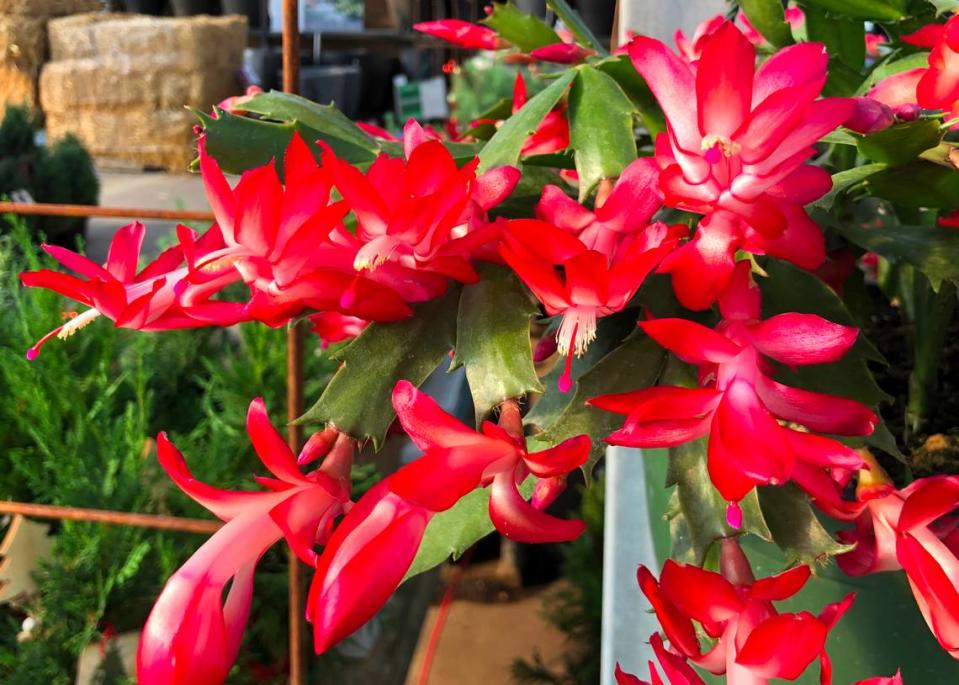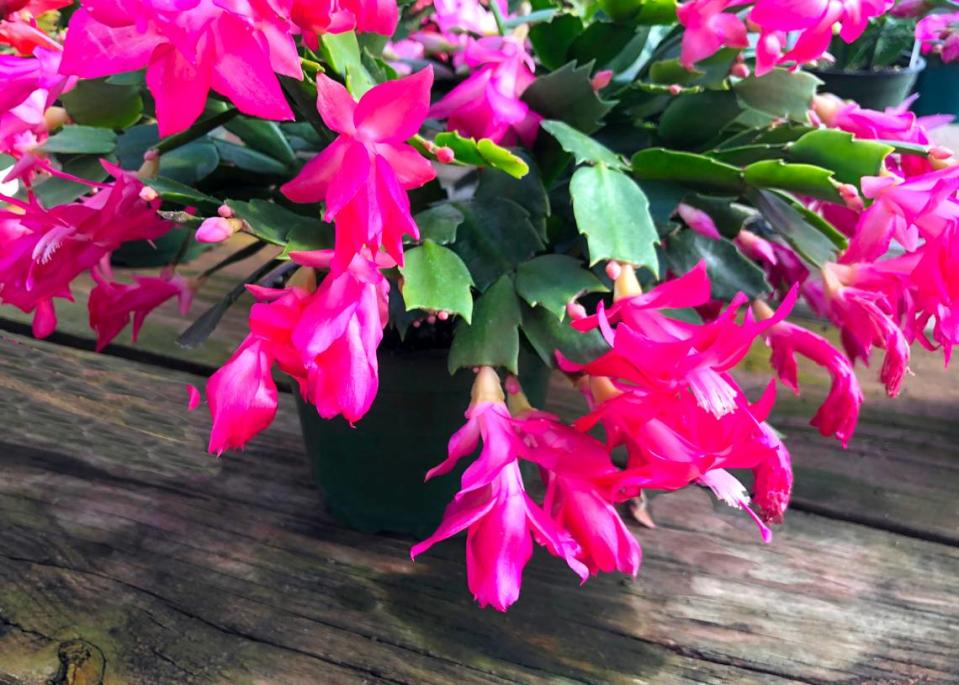Facts about Christmas cacti and how to care for the tropical plants that thrive in cool temps
Run these facts through your profile machine and you’re probably not going to get “cactus” back as the answer.
▪ Native to tropical rainforests along the Atlantic Coast of Brazil — both directions from Rio de Janeiro.
▪ Grows in clouds and drizzle at altitudes of up to 9,000 feet.
▪ Prefers shaded, cool sites where overnight temperatures drop into the 50s. Definitely not fond of arid heat and intense summer sun like almost all of their cactus cousins.
▪ In those settings, found growing on moss-covered branches and boulders or in leaf humus in crotches of tree limbs.
▪ Put in botanists’ terms, these plants are epiphytic, meaning that they grow hanging from trees without gaining nourishment from the supporting plants. (Spanish moss is a good comparison with which you may be more familiar.)
Early world travelers must have had a good eye for unusual and beautiful plants (and good climbing boots), because they took these lovelies back to Europe before 1820. And therein started the confusion in the botanical names for the group.
I’m not even going to attempt to explain the first “actinomorphic” or the last “zygomorphic.” Or that the flowers are “radially symmetrical” and that the flowers have 20 to 30 tepals each. I’ve read that stuff three times now, and frankly, I’m just done.
Suffice to say that the botanists, after all their arm-wrestling was finished, have decided that the plants all go into the genus Schlumbergera. Really? 200 years of arguing, and they give us a name that no one can pronounce?
To the goal line: There are two main groups and hundreds of hybrids:
▪ Cultivars of Schlumbergera truncata: Stem segments have pointed teeth somewhat like a crab’s claws. Flowers are generally held horizontally or slightly above the horizontal line.
▪ Cultivars of S. russelliana, known collectively as the Buckleyi group. These have rounded stem segments with flowers that hang down below the horizontal.
When I was a kid I had a fetish over cacti and succulents (still do). I had several hundred genera, species and cultivars (“cultivated varieties”) — hundreds of types of haworthias alone. But I don’t recall seeing big numbers of cultivars of Christmas cacti. There probably were enthusiasts out there, but you didn’t run across all that many in collections in greenhouses and nurseries.
To realize the incredibly wide range of colors and types available to us today, all you have to do is search on eBay. Use the one word “Schlumbergera” (check your spelling). I was amazed to find 403 different cultivars when I searched just a few days ago. I always buy from U.S.A. growers, and when buying succulents, bromeliads and other plants I’ve always been extremely pleased.
Care of Christmas cacti
How does someone in Texas grow a plant that’s used to a cool tropical rainforest? It’s not as difficult as you might think.
▪ Propagate Christmas cacti from short pieces of stems. Those “links” are actually sections of stems. This plant has no true leaves. A cutting should consist of three to five segments of stem stuck down into a very porous rooting medium that you can keep moist but not wet.
▪ Choose a loose, highly organic potting soil. I don’t try to grow my plants as epiphytes like I would a tillandsia or staghorn fern. I raise them in pots or hanging baskets. I fill the containers with a potting soil made up of 50% sphagnum peat moss, 25% finely ground pine bark mulch and 25% expanded shale. If I have access to some really good compost, I might decrease the peat and bark by 5% each and stir in the compost.
▪ Call me old-fashioned, but I still prefer terra cotta clay pots, the types that are 74% as tall as they are wide (called “azalea” pots). They “breathe” better since they’re porous, so that lets me believe that I’m less likely to overwater my plants. For the record, all commercial growers do quite well using plastic pots.
▪ I grow my plants in bright shade — no direct sunlight. I’ve had many people send me photos of plants they’ve handed down for two or three generations, and those plants have generally never been outdoors. They’re always on a bright tabletop near a window, but never in hot, direct sunlight.
▪ Remember that this plant is photoperiodic. (Is there no end to crazy words with this plant?) That means that Christmas cacti, like poinsettias, mums, and kalanchoes, measure the length of the dark period to determine when it’s time to start producing flowers.
You’re going to have it in the house with you. Keep it in a spot that can be totally dark for 13 uninterrupted hours each night beginning in early October if you expect it to come into bloom in November or December. For the record, the Buckleyi group blooms earlier, earning it the common name of “Thanksgiving” cactus.
And that takes us to the final chapter in this unsettling saga. “Thanksgiving” isn’t a holiday in England. Or France. Or where these plants are native. And parts of the world don’t celebrate Christmas. And in the Southern Hemisphere these plants don’t bloom in December anyway.
As a result, common names are a dime a dozen. In Brazil, it’s Flor de Maio (May flower). It’s called “holiday cactus” or “crab cactus” in other countries.
And botanists just go off in their corners and mumble “Schlumbergera.” (My dad and uncle were both Ph.D. botanists. I hope they’ll forgive me.)


